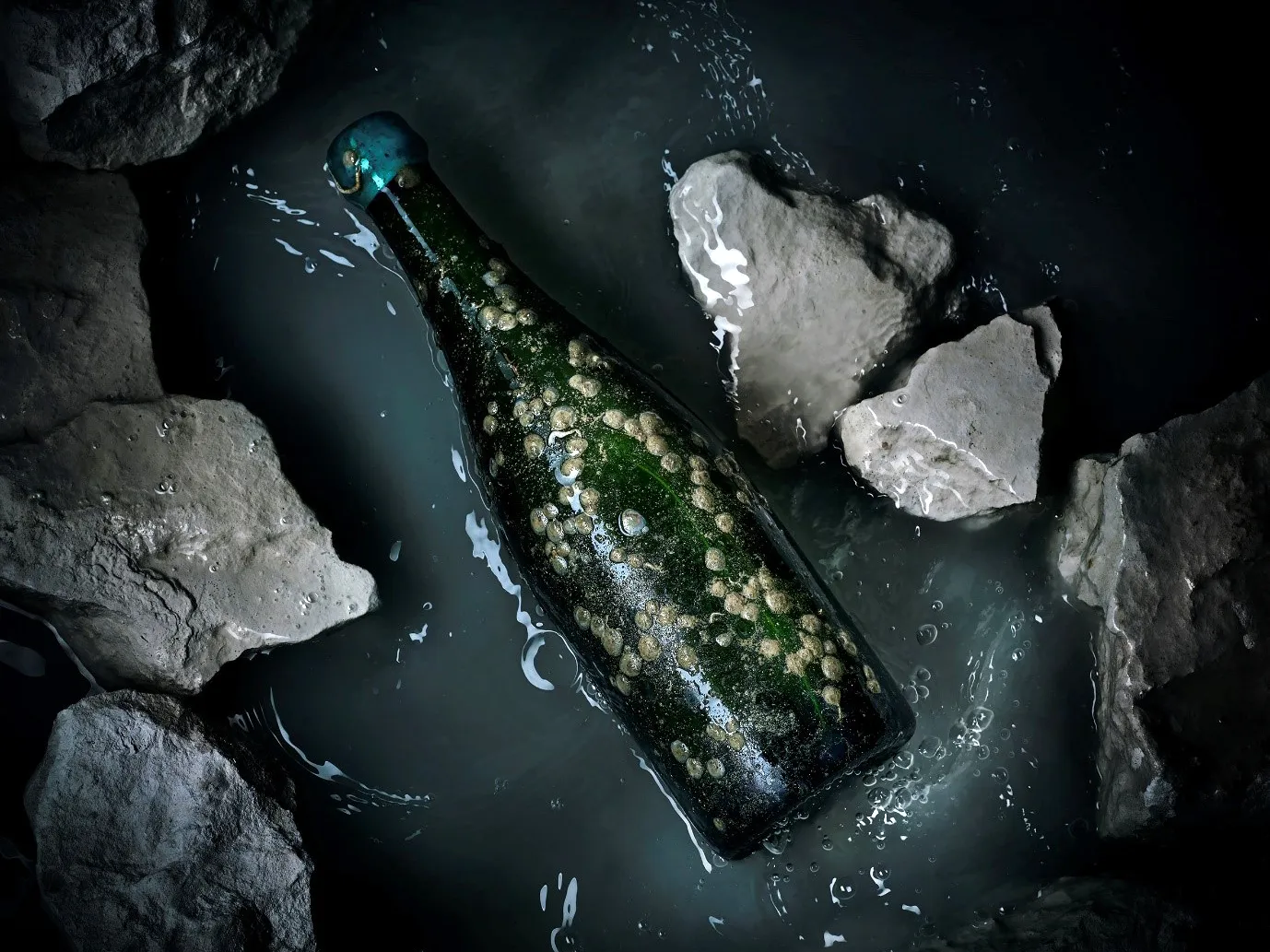Undersea-Aged Champagne Is Starting to Surface
Some experts believe the science of champagne has applications in ballistics and rocketry, and now producers are trialing deep-sea aging, seeking the salty superiority of a life under pressure.

If you’ve ever been hit by a flying champagne cork, you will be painfully aware of the pressure in a bottle of fizz. And that pressure inside—and outside—the bottle has caught the imaginations of champagne innovators.
“We conduct many trials every year to fine-tune the pressure to the vintage,” says Louis Roederer’s chef de cave, Jean Baptiste Lécaillon. “We have a lower pressure—so smaller bubbles—[because] we want a seamless and soft mousse.”
The pressure inside a bottle of champagne is typically around 6 bar, or three times the pressure of a car tire. But Louis Roederer champagnes can range from 6 to 4.5 bar. “The more acidity you have in the wine, the more aggressive the feeling of the bubbles ... This is also why we are on the low side,” explains Lécaillon, “especially on Cristal, which is often non-malo [referring to malolactic fermentation] and low pH.” The newly released Cristal 2015, he says, “is a great example of this featherlight mousse … It is at the same time delicious, effortlessly intense, and delicate.”
If you’ve ever been hit by a flying champagne cork, you will be pOne only needs a basic grasp of physics to realize that storing champagne at higher temperatures will increase the pressure inside. But scientists were astonished to find that when a bottle stored at 20 degrees Celsius (well above cellar temperature) was uncorked, the velocity of gas expelled from the bottleneck momentarily reached almost Mach 2—twice the speed of sound.
The Ballistics of Bubbly
Researcher Gérard Liger-Belair, professor of chemical physics at the University of Reims Champagne-Ardenne, likens this phenomenon “to what happens with rocket plume exhausts.” The pressure causes the CO2 to freeze and turn to dry ice when suddenly released, creating a plume at the bottle opening.
Liger-Belair is a specialist in champagne and effervescence, and the author of Uncorked: The Science of Champagne. But he hopes the findings, published in an academic journal last year, will also have applications in the fields of ballistics and rocketry.
The pressure in a champagne bottle falls over the years, resulting in smaller and scarcer bubbles—and that more composed, rather quieter character can often be part of the charm of a long-aged cuvée.
“There’s not so much of a difference of size and number of bubbles at Dom Pérignon from one vintage to another,” he adds. “Nevertheless, I consider that the way you feel the bubbles on your palate is truly representative of the wine’s balance. As if the bubbles were carrying the whole personality of each vintage.””
He compares Dom Pérignon 2012: “You feel the bubbles directly on the first ‘attack’ of the wine. They’re tingling your palate with precision and energy.” Then, with the newly released Dom Pérignon 2013: “The sensation of bubbles comes later, on the mid-palate. The sensation is much milder, caressing your palate and revealing the elegance of 2013.”
Send in the Fizz Robot
Bubbles are also experienced psychologically. Sigfredo Fuentes, an associate professor in digital agriculture and food/wine sciences at the University of Melbourne, found that people associated seeing intensity and longevity of bubbles with a better quality of champagne, even if it was just cheap plonk that had been sonically bubbled.
Using these insights, Fuentes’ team has created the FIZZeyeRobot, a machine that pours and measures foam lifespan, as well as gas released. AI software predicts how this affects flavor compound release, and in turn, how potentially palatable the drink will be.
Meanwhile, in experiments around pressure outside the bottle, a number of wine producers are trialing deep-sea aging.

For the past two years, Champagne Drappier has been aging stocks of its Brut Nature in a cage 40 meters down in the English Channel, not far from Jersey. “It’s almost completely dark with a temperature of 11 to 13 degrees Celsius, very similar to our cellars,” says Michel Drappier. “What’s different is the pressure, which at 4 bar is around four times what it is at sea level. After two years, the level of dissolved CO2 in the underwater champagne is around 10 percent higher, because the CO2 hasn’t escaped. We are only at the beginning of this experiment, but I already find it fresher and more integrated.” Indeed, I compared one of these bottles with a land-aged Brut Nature, and it was certainly different. I found the former more sherbety and sprightly, with a finer texture.

This October, the English sparkling winemaker Exton Park will release a limited-edition coffret containing two bottles of its Exton Park Blanc de Blancs 2014—one aged on terra firma and one aged for a year 60 meters down in the English Channel near Brittany. Tasting the two wines, blind, the submarine is more expressive and lively. “The bubbles under the sea are smaller, more integrated. It’s more complete, more harmonious,” says Exton Park winemaker Corinne Seely, who insists it’s more than just a PR stunt, and that genuine exploration is taking place. “I want to understand more about what’s happening in the wine, so all of these details interest me.”
However, aging underwater is complicated and expensive. It won’t replace the traditional cave any time soon, but it may yield some useful insights about maturation. And that’s worth a barnacle or two.












